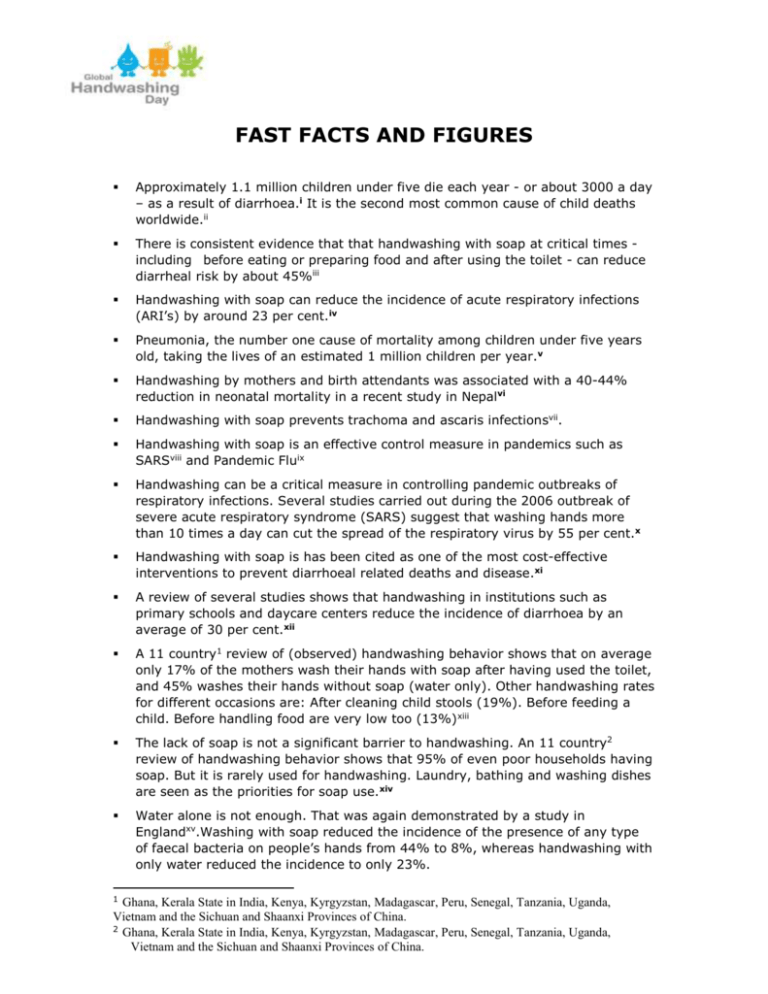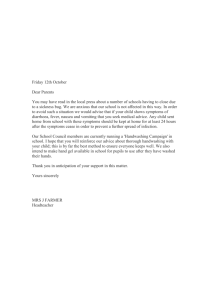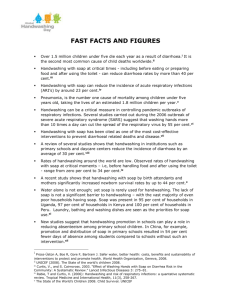Global Handwashing Day - Facts ans Figures
advertisement

FAST FACTS AND FIGURES Approximately 1.1 million children under five die each year - or about 3000 a day – as a result of diarrhoea.i It is the second most common cause of child deaths worldwide.ii There is consistent evidence that that handwashing with soap at critical times including before eating or preparing food and after using the toilet - can reduce diarrheal risk by about 45%iii Handwashing with soap can reduce the incidence of acute respiratory infections (ARI’s) by around 23 per cent.iv Pneumonia, the number one cause of mortality among children under five years old, taking the lives of an estimated 1 million children per year.v Handwashing by mothers and birth attendants was associated with a 40-44% reduction in neonatal mortality in a recent study in Nepalvi Handwashing with soap prevents trachoma and ascaris infectionsvii. Handwashing with soap is an effective control measure in pandemics such as SARSviii and Pandemic Fluix Handwashing can be a critical measure in controlling pandemic outbreaks of respiratory infections. Several studies carried out during the 2006 outbreak of severe acute respiratory syndrome (SARS) suggest that washing hands more than 10 times a day can cut the spread of the respiratory virus by 55 per cent.x Handwashing with soap is has been cited as one of the most cost-effective interventions to prevent diarrhoeal related deaths and disease.xi A review of several studies shows that handwashing in institutions such as primary schools and daycare centers reduce the incidence of diarrhoea by an average of 30 per cent.xii A 11 country1 review of (observed) handwashing behavior shows that on average only 17% of the mothers wash their hands with soap after having used the toilet, and 45% washes their hands without soap (water only). Other handwashing rates for different occasions are: After cleaning child stools (19%). Before feeding a child. Before handling food are very low too (13%) xiii The lack of soap is not a significant barrier to handwashing. An 11 country2 review of handwashing behavior shows that 95% of even poor households having soap. But it is rarely used for handwashing. Laundry, bathing and washing dishes are seen as the priorities for soap use. xiv Water alone is not enough. That was again demonstrated by a study in Englandxv.Washing with soap reduced the incidence of the presence of any type of faecal bacteria on people’s hands from 44% to 8%, whereas handwashing with only water reduced the incidence to only 23%. 1 Ghana, Kerala State in India, Kenya, Kyrgyzstan, Madagascar, Peru, Senegal, Tanzania, Uganda, Vietnam and the Sichuan and Shaanxi Provinces of China. 2 Ghana, Kerala State in India, Kenya, Kyrgyzstan, Madagascar, Peru, Senegal, Tanzania, Uganda, Vietnam and the Sichuan and Shaanxi Provinces of China. New studies suggest that handwashing promotion in schools can play a role in reducing absenteeism among primary school children. In China, Colombia and Egypt primary school absenteeism due to diarrhea or and respiratory infections dropped between 20% and 50% as a result of better handwashing practices xvi. In Eqypt, the intensive handwashing promotion didn’t only reduce diarrhoea related absenteeism. Absences from laboratory-confirmed influenza dropped by 50%, and conjunctivitis related absences by 67%. In the industrialized world handwashing in schools reduces absenteeism too. Studies focussing on absenteeism caused by gastrointestinal and respiratoryrelated illnesses in industrialized countries show that the number of days lost as a result of these diseases can drop between 25% and 50%xvii when hand-hygiene is promoted. Among school going children (6-14 years) in central India (Wardha district) the prevalence of intestinal parasitic infections was 23 times as high among children having dirty untrimmed nails, and 8 times as high among those having poor handwashing practices (other social-economic factors did not play a role)xviii. A test on the presence of faecal pathogens in primary schools in Greece showed that on 52.9% of pupils’ hands and on 16.7% of other school surfaces faecal pathogens were presentxix There is often a significant discrepancy between handwashing knowledge and practices. In a study in Bangladesh where about 47% of caregivers reported washing both hand with soap after defecation, and 51% demonstrated this proper handwashing technique when asked how they wash their hands, in structured observation only 33% of caregivers and 14% of all persons observed did in fact wash both hands with soap after defecation xx. i UNICEF/WHO 2011. Levels and trends in Child Mortality. Report 2011. Estimates Developed by the UN inter-agency group on child mortaility. ii Black RE, Cousens S, Johnson HL, Lawn JE, Rudan I, Bassani DG, Jha P, Campbell H, Fischer Walker C, Cibulskis R, Eisele T, Liu L, Mathers C, for the Child Health Epidemiology Reference Group of WHO and UNICEF. Global, regional, and national causes of child mortality in 2008: a systematic analysis. The Lancet. 5 June 2010; 375(9730): 1969-87. iii CHERG 2010. Sandy Cairncross, Caroline Hunt, Sophie Boisson, Kristof Bostoen, Val Curtis, Isaac CH Fung, and Wolf-Peter Schmidt Water, sanitation and hygiene for the prevention of diarrhoea.Int. J. Epidemiol. 2010 39: i193-i205. Rabie, T and Curtis, V. (2006): Handwashing and risk of respiratory infections: a quantative systematic review. Tropical Medicine and International Health, 11(3), 258-267. iv v The State of the World’s Children 2008. Child Survival. UNICEF Victor Rhee; Luke C. Mullany; Subarna K. Khatry; Joanne Katz; Steven C. LeClerq; Gary L. Darmstadt; James M. Tielsch. Maternal and Birth Attendant.Hand Washing and Neonatal Mortality in Southern Nepal Arch Pediatr AdolescMed. 2008;162(7):603-608. vi vii Fung, I.C-H. & Cairncross, S. (2009). Ascariasis and handwashing. Transactions of the Royal Society of Tropical Medicine and Hygiene, 103(3), 215-222. viii Fung, I. C.-H. & Cairncross, S. (2006). Effectiveness of handwashing in preventing SARS: a review. Tropical Medicine and International Health, 11(11), 1749–1758. ix Jefferson, T., Foxlee, R., Mar, C.D., Dooley, L., Ferroni, E., Hewak, et al. (2008). Physical interventions to interrupt or reduce the spread of respiratory viruses: systematic review.BMJ, 336, 77-80. Tom Jefferson, Chris Del Mar, Liz Dooley, Eliana Ferroni, Lubna A Al-Ansary, Ghada A Bawazeer, Mieke L van Driel, Ruth Foxlee, Alessandro Rivetti. (2009). Physical interventions to interrupt or reduce the spread of respiratory viruses: systematic review. BMJ 2009;339:b3675, doi: 10.1136/bmj.b3675 (Published 22 September 2009) x Cairncross, S. Valdmanis V. 2006. Water supply, sanitation and hygiene promotion. Chapter 41. In. Disease Control Priorities in Developing Countries. Second Edition. Edt. Jameson et al 2006. The World Bank. Washington DC: National Institutes of Health. xi Cochrane 2008 - Ejemot RI, Ehiri JE, Meremikwu MM, Critchley JA. Hand washing for preventing diarrhoea. Cochrane Database of Systematic Reviews 2008, Issue 1. Art. No.: CD004265. DOI: 10.1002/14651858.CD004265.pub2. xii xiii Curtis, V.A., Danquah, L.O. & Aunger, R.V., 2009. Planned, motivated and habitual hygiene behaviour: an eleven country review. Health Education Research, 24, pp.655-673. xiv Second Planners guide – pg. 41 xv Burton, Maxine, Emma Cobb, Peter Donachie, Gaby Judah, Val Curtis, and Wolf-Peter Schmidt. “The Effect of Handwashing with Water or Soap on Bacterial Contamination of Hands.” International Journal of Environmental Research and Public Health 8 (January 6, 2011): 97-104. xvi Three Studies : Bowen, A. et al., 2007. A cluster-randomized controlled trial evaluating the effect of a handwashing-promotion program in Chinese primary schools. The American Journal of Tropical Medicine and Hygiene, 76(6), pp.1166-1173. Talaat, M., 2011. Effects of Hand Hygiene Campaigns on Incidence of Laboratory-confirmed Influenza and Absenteeism in Schoolchildren, Cairo, Egypt. Emerging Infectious Diseases. Available at: http://wwwnc.cdc.gov/eid/article/17/4/10-1353_article.htm [Accessed September 14, 2011]. Lopez-Quintero, C., Freeman, P. & Neumark, Y., 2009. Hand Washing Among School Children in Bogota, Colombia. Am J Public Health, 99(1), pp.94-101. xvii 4 studies: Master, D., Hess Longe, S.H. & Dickson, H., 1997. Scheduled hand washing in an elementary school population. Family Medicine, 29(5), pp.336-339. Dyer, D.L., Shinder, A. & Shinder, F., 2000. Alcohol-free instant hand sanitizer reduces elementary school illness absenteeism. Family Medicine, 32(9), pp.633-638. White, C.G. et al., 2001. Reduction of illness absenteeism in elementary schools using an alcohol-free instant hand sanitizer. The Journal of School Nursing: The Official Publication of the National Association of School Nurses, 17(5), pp.258-265. Guinan, M., McGuckin, M. & Ali, Y., 2002. The effect of a comprehensive handwashing program on absenteeism in elementary schools. American Journal of Infection Control, 30(4), pp.217-220. xviii Dongre, A.R.; Deshmukh, P.R.; Boratne, A.V.; Thaware, P. and Garg, B.S. (2008) An approach to hygiene education among rural Indian school going children. Online Journal of Health and Allied Sciences, 6 (4). ISSN 0972-5997 xix Kyriacou, A. et al., 2009. Screening for faecal contamination in primary schools in Crete, Greece. Child: Care, Health and Development, 35(2), pp.159-163. xx Halder, A. et al., 2010. Observed hand cleanliness and other measures of handwashing behavior in rural Bangladesh. BMC Public Health, 10(1), p.545.



